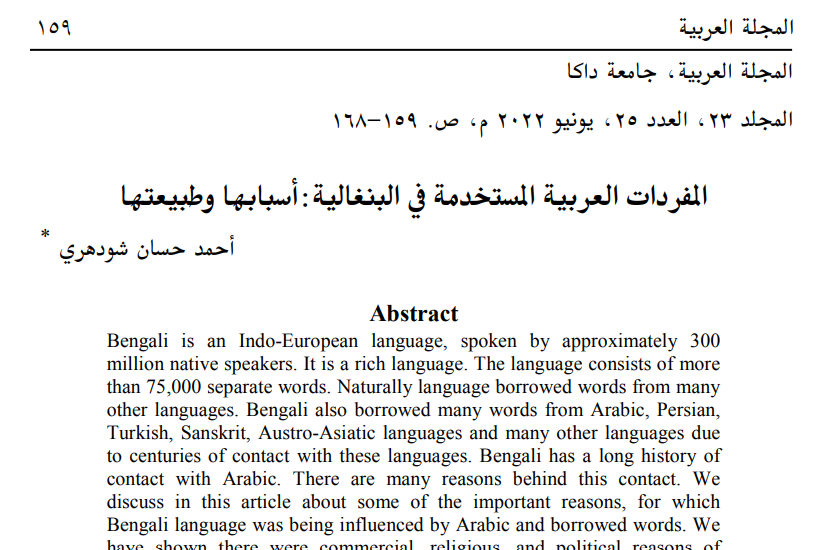المفردات العربية المستخدمة في البنغالية: أسبابها وطبيعتها
DOI:
https://doi.org/10.62295/mazallah.v23i25.26Keywords:
Keywords: Arabic words in bengali, Arabic influence on Bengali languageAbstract
Bengali is an Indo-European language, spoken by approximately 300 million native speakers. It is a rich language. The language consists of more than 75,000 separate words. Naturally language borrowed words from many other languages. Bengali also borrowed many words from Arabic, Persian, Turkish, Sanskrit, Austro-Asiatic languages and many other languages due to centuries of contact with these languages. Bengali has a long history of contact with Arabic. There are many reasons behind this contact. We discuss in this article about some of the important reasons, for which Bengali language was being influenced by Arabic and borrowed words. We have shown there were commercial, religious, and political reasons of communications between Arabic and Bengali. We will also discuss in this article the nature of words borrowed from Arabic into Bengali. Some Arabic words were added directly without any changes like hakim (حاكم), some other words changed extremely as mokkhom(†gvÿg) from muhkam (محكم) or slightly as chokra (†QvKiv) from sugra (صغرى). Some of the borrowed Arabic words are used with another Arabic word like Lakheraj (jv‡LivR from لا خراج), some are used in Bengali with other English as Head Mawlana (†nW gvIjvbv), Persian as Zabardasti (Rei`w¯Í) or Bengali words as Kumatlab (KzgZje). Hopefully this article will help us to understand the history, type and nature of Bengali words borrowed from Arabic.
Keywords: Arabic words in bengali, Arabic influence on Bengali language
References
أحمد، إي.ك.إيم. نذير. 1999. قدوم الإسلام في بنغلاديش(বাংলাদেশে ইসলামের আগমণ)داكا: بنغلاديش إسلامي سنتر.
أكرم خان، محمد. 1965. التاريخ الاجتماعي للبنغال المسلمة(মোছলেম বঙ্গের সামাজিক ইতিহাস). داكا: بنغلا أكاديمي.
طالب، عبد المنان. 1980. الإسلام في بنغلاديش (বাংলাদেশে ইসলাম). داكا: المؤسسة الإسلامية بنغلاديش.
مجموعة دار، رامش سندرا. 2017. تاريخ بنغلادي، الجزء الثاني (বাংলাদেশের ইতিহাস, ২য়খন্ড). داكا: ديب بروكاشوني.
سرور، أحمد فتحى. 2003. نظرات في عالم متغير . مصر: دار الشروق للنشر والتوزيع.
Chowdhury, Jamil. 2016. Adhunik Bangla Abhidhan. Dhaka: Bangla Academy.
Mamud, Dr. Hayat. 2019. Bhasha Shikkha. Dhaka: The Atlas Publishing House.
Hilali, Ghulam Maqsud. 2008. Perso-Arabic Elements in Bengali. Rajshahi: Hilali Foundation.
Mirdehghan, Mahinnaz. 2010. Persian, Urdu, and Pashto: A comparative orthographic analysis. Writing Systems Research Vol. 2, No. 1, 9–23
Ethnologue, Languages of the World. 2019. Bengali Language , United States. https://www.ethnologue.com/language/ben , Retrieved 1 March, 2022.
UNESCO: International Mother Language Day , https://en.unesco.org/commemorations/motherlanguageday, Retrieved 1 March, 2022.
Bhattacharjee, Kishalay. 30 April 2008. "It's Indian language vs Indian language". NDTV.com. https://web.archive.org/web/20130723023746/http://www.ndtv.com/convergence/ndtv/story.aspx?id=NEWEN20080048434 , Retrieved 1 March, 2022.
The World Factbook. 2022. www.cia.gov. Central Intelligence Agency. https://www.cia.gov/the-world-factbook/countries/world/ , Retrieved 1 March, 2022.


